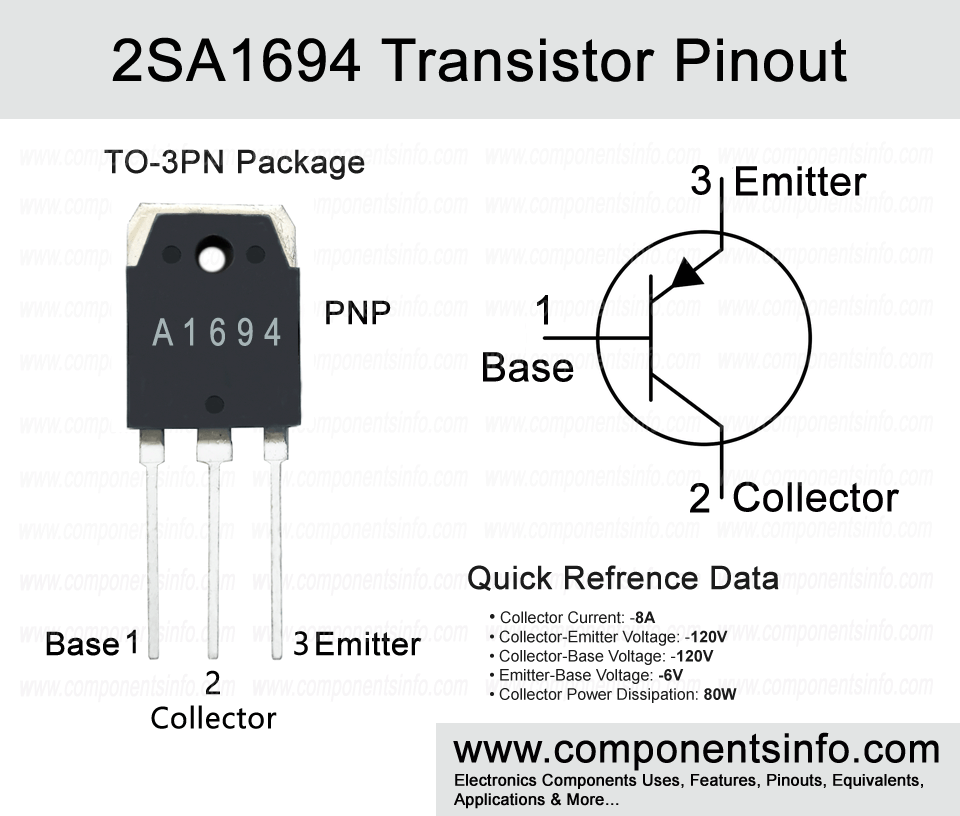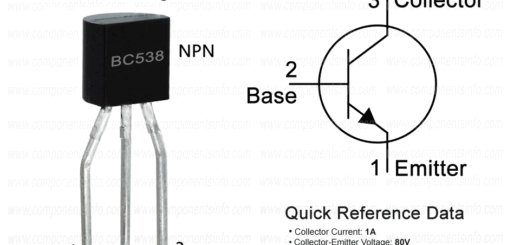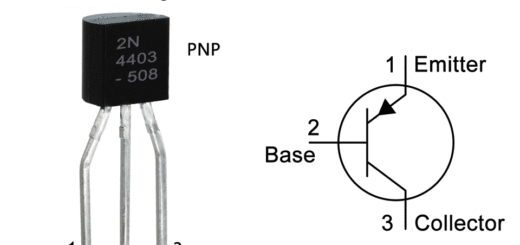2SA1694 Transistor Pinout, Equivalent, Features, Applications and other Data
In this post we are going to discuss 2SA1694 transistor pinout, applications, features, equivalents and other detail about this PNP power transistor.
Absolute Maximum Ratings:
- Package Type: TO-3PN
- Transistor Type: PNP
- Max Collector Current(IC): -8A
- Max Collector-Emitter Voltage (VCE): –120V
- Max Collector-Base Voltage (VCB): –120V
- Max Emitter-Base Voltage (VEBO): –6V
- Max Collector Dissipation (Pc): 80Watt
- Minimum & Maximum DC Current Gain (hFE): 50 To 180
- Max Storage & Operating temperature: -55 to +150 Centigrade
NPN Complementary:
NPN Complementary of 2SA1694 is 2SC4467
Replacement & Equivalent
2SA1386, 2SA2151, 2SA1492, 2SA1490, 2SA1186, 2SA1105, 2SB1317, 2SA2151.
2SA1694 Transistor Explained / Description:
The 2SA1694 is a PNP transistor designed for use in audio and general-purpose applications. It is a power transistor and offers many good features, such as good collector current, high collector emitter voltage, good linearity of DC current gain, a transition frequency of upto 20MHz, fast switching speed and the availability of its NPN complimentary transistor.
The absolute maximum ratings of the transistor are as follows: collector current of -8A, collector-emitter voltage of -120V, collector-base voltage of also -120V, emitter-base voltage of -6V, base current is of -3A, collector power dissipation is 80W, junction temperature of 150°C and storage temperature range is from -55°C to 150°C.
The transistor is available in three different hFE classifications, which can be identified by an alphabetic code written after the part number. if that alphabet is “O” the DC current gain will be 50 to 100, if it is “P” then its DC current gain will be 70 to 140 and if it is “Y”, the DC current gain will be 90 to 180.
How to Use This Transistor:
The 2SA1694 is a bipolar junction transistor (BJT). Therefore the using procedure is same as we use any other BJT by connect the emitter pin with the positive rail of the circuit, applying signal to its base pin and receiving the output at the collector pin.
This is a basic guide on how to use the transistor but to design a proper working circuit, you will need to use some passive components, and doing so requires knowledge and experience in electronic circuit design.
Applications:
Audio Amplifier Circuits
PWM Circuits
Switching Regulators
Audio Amplifier Stages
DC to DC Converters
Battery Management Systems
Switching load of up to -8A
Safe Operating Guidelines:
Here are some important guidelines to safely operate the transistor.
- Always use the transistor under its absolute maximum ratings and say at least 20% to 30% below from these ratings.
- Use suitable heatsink with the transistor
- Check pin layout before using in your circuit.
- Always store and operate at temperatures above -55°C and under +150°C.
Datasheet:
To download the datasheet just copy and paste the below link in your browser.
https://www.alldatasheet.com/datasheet-pdf/view/1090538/NJSEMI/2SA1694.html



